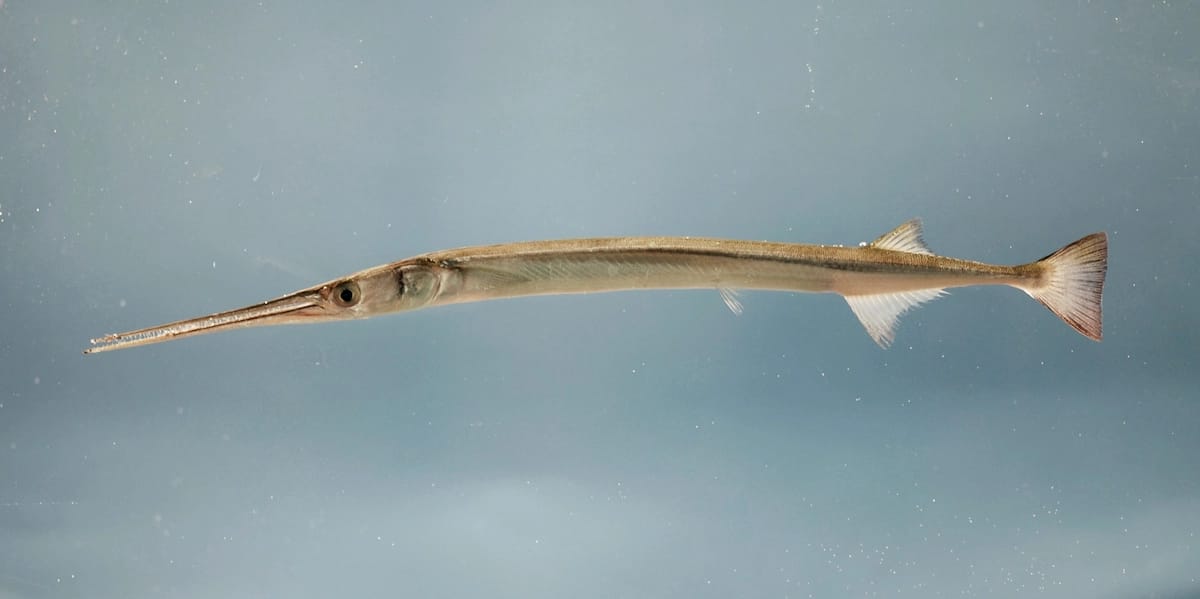If anyone in my family has a question about the ocean, I’m the first person they ask. While I was on vacation recently, my sister would constantly point at things swimming beneath the waves and ask me, “What’s that?” One of these creatures was a needlefish, and at the time I knew almost nothing about them. Who were these little swimming sword fighters who seem ready to joust on any occasion? It was eerie watching these long slender fish swim among humans enjoying the water. Would they challenge anyone to a duel? I had questions, and, honestly, my search for the answers led me down some dark paths.
Am I now afraid of needlefish? Possibly. Do I think they are the villainous rogues of the ocean’s surface? Absolutely. You may look at that little fish and think nothing of it but I’m here to tell you: Think again.
Want to learn more about ocean animals?
Sign up to receive our emails.
document.addEventListener(‘DOMContentLoaded’, function() {
const form = document.getElementById(’email-signup-648b430239620′);
form.querySelector(‘.rsform__field–email’).addEventListener(“nb:result”, e => {
const nbStatus = form.querySelector(“[name=”nb_email_status”]”);
const nbDate = form.querySelector(“[name=”nb_validation_date”]”);
const tokenField = form.querySelector(“[name=”token”]”);
const currentDate = new Date();
nbStatus.value = e.detail.result.response.status;
nbDate.value = currentDate.toISOString().split(‘T’)[0];
grecaptcha.enterprise.ready(async () => {
const token = await grecaptcha.enterprise.execute(‘6Lcmr3shAAAAAAVRlvJrsUufEEQuItzNDlkpmB2g’, {action: ‘verify’});
tokenField.value = token;
});
});
});
<!– –>
Where do you find needlefish?
Just like that face that haunts your dreams, once you know what needlefish are, you’ll see them everywhere. They hang out in shallow waters or near the surface of the ocean. Most live in saltwater, though there are a few species that live in freshwater or brackish (mix of saltwater and freshwater) environments. Needlefish like warm water so you’ll often find them in tropical areas around the world. Wherever you might head on a relaxing vacation, a needlefish might be there lurking, just offshore.
What’s that big pointy sword-looking thing for?
It’s clear how a needlefish got its name. In the front of its face is a long, narrow mouth that looks a bit like a needle. While that swordlike front is scary enough, it opens into a mouth with tons of small pointy teeth. These teeth are not for chewing but for making sure their prey does not escape. Which means a needlefish swallows their prey whole.
What do needlefish eat?
Needlefish usually eat smaller fish, but how they digest them is a weirder story. That’s because needlefish don’t have stomachs. At some point in their evolution, they ditched that organ in favor of an acid-free approach to breaking down their meals. That means nothing turns a needlefish’s stomach because they’ve got no stomach to turn.
Scarier still, needlefish are smart hunters that seem to take advantage of an underwater phenomenon called Snell’s window. If you have looked up when you were swimming underwater you might have noticed a cone of light that allows you to see up to the surface. That’s Snell’s window, which is caused by the way light refracts through water. While things inside the window are clear, everything around it is dark or distorted. A needlefish will use this disorientation to its advantage, allowing it to get very close to its prey without their being any the wiser. Waiting in the shadows for the right time to attack with your sword? A needlefish sounds like a rogue if I ever saw one.

if(typeof window.oc_media_credits === ‘undefined’) {
window.oc_media_credits = {};
}
window.oc_media_credits[69219] = “SEFSC Pascagoula Laboratory; Collection of Brandi Noble, NOAA/NMFS/SEFSC”;
How fast is a needlefish?
A needlefish will make short jumps out of the water while hunting its prey. Needlefish can move up to 40 mph when they make their leaps. Needlefish move so fast that they can tail walk, where they appear to walk on the water straight up on their back ends. They’ll even skip along the surface like you might skip a stone, gliding along the waves.
In their haste, they will often jump over low lying boats instead of swimming under. This can be dangerous for humans on those boats who can be struck by their sharp beaks at high speed. Swimmers, boaters, kayakers and windsurfers have been struck and seriously injured by needlefish. It is important to note, though, that these incidents are rare and accidental. Needlefish aren’t aggressive towards humans and usually avoid contact all together. While I won’t be signing up for a needlefish fan club anytime soon, these rapscallions are an important part of our ocean ecosystem. The truth is, they may have more reason to be afraid of us then we have to be afraid of them. In Pakistan, a needlefish was found dead trapped in a discarded plastic cup that had ended up in the ocean. Living closer to the shores means they also live in habitats polluted by our trash. No creature deserves to live in a dump. Take action with Ocean Conservancy to prevent plastic pollution now.
The post Meet the Needlefish appeared first on Ocean Conservancy.

